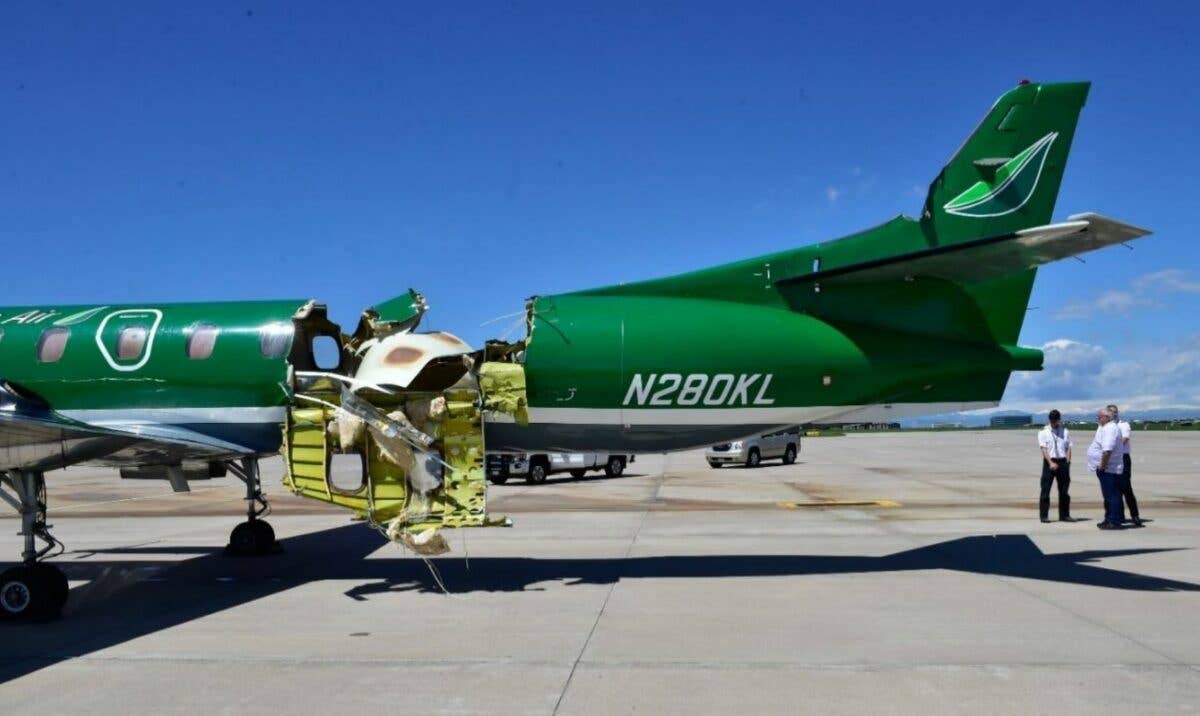NTSB Releases Final Report on Colorado Midair
Excessive speed and lack of communication were to blame in the 2021 midair collision, according to NTSB.

The Swearingen Metroliner after the accident. [Credit NTSB]
Accident investigators cite pilot error and a failure to communicate by air traffic control as causal factors in the midair collision between a Cirrus SR22 and a Swearingen Metroliner near Centennial Airport (KAPA) in May of 2021. There were no fatalities as a result of the collision.
According to the National Transportation Safety Board (NTSB), both aircraft were on approach to parallel runways that were controlled by different controllers on different control tower frequencies at the time of the accident.
Parallel Runway Operations
At approximately 10:23 a.m. local time on May 12, 2021, both the Cirrus and the Metroliner were approaching to land at Centennial Airport. The Cirrus was assigned to Runway 17R, and the Metroliner to Runway 17L.
"The pilot of the Swearingen was established on an extended final approach for the left runway, while the pilot of the Cirrus was flying a right traffic pattern for the right runway," the NTSB said in its final report released this week.
According to NTSB, data from an on-board recording device showed that the Cirrus’ airspeed on the base leg of the approach was more than 50 knots above the manufacturer’s recommended speed of 90 to 95 knots.
According to the Cirrus pilot’s operating handbook and aircraft flight manual” (POH/AFM), the recommended approach speed for the airplane was 90 to 95 knots indicated airspeed (kias) with flaps up, 85 to 90 kias with 50 percent flaps, and 80 to 85 kias with 100 percent flaps.
The data recovered from the Cirrus indicated that during the downwind portion of the airplane’s approach, the airspeed was about 125 kts., and the flaps were up. When the Cirrus turned on the base leg of the traffic pattern, the recorded airspeed had increased to 148 knots, but still had no flaps deployed. When the pilot turned from base to final, the flaps were lowered approximately 50 percent. Four seconds later, the impact occurred, with the Cirrus approximately halfway through the turn to final at an airspeed of 140 knots at an altitude of 6,619 feet msl.
The excessive speed increased the radius of the turn for the Cirrus, causing the pilot to overshoot the extended centerline for Runway 17R. The Cirrus veered into the airspace of the extended centerline for the left runway, where it collided with the Metroliner approximately three miles from the airport.
Both aircraft were substantially damaged. The Cirrus became uncontrollable, so the pilot activated the emergency parachute. The pilot of the Metroliner declared an emergency but was able to make what the NTSB describes as an 'uneventful landing' on the runway. The Cirrus came down approximately three miles from the runway.
According to the NTSB, "During the approach sequence the controller working the Swearingen did not issue a traffic advisory to the pilot regarding the location of the Cirrus and the potential conflict."
However, the controller working the Cirrus did issue a traffic advisory regarding the Swearingen on the parallel approach.
The issuance of traffic information during simultaneous parallel runway operations was required by FAA Order JO 7110.65Y, which details air traffic control procedures and phraseology for use by persons providing air traffic control services.
Excessive Speed in Turns
Per the FAA's Airplane Flying Handbook Chapter 3, figure 3-14, when the angle of bank is held constant, a slower airspeed will result in a smaller turn radius and greater turn rate. Conversely, a greater airspeed means a greater turn radius.
There have been other accidents where pilots were behind the aircraft as the high airspeed resulted in a turn with a greater radius resulting in a collision. In 2006 New York Yankees pitcher Cory Lidle and his flight instructor Tyler Stanger were killed when Lidle's Cirrus SR20 collided with a high rise apartment building during an attempt to perform a 180 degree turn over the East River VFR corridor. Twenty-one people were injured, and the building was heavily damaged by the subsequent fire.
The NTSB determined that the Cirrus was going too fast to make the turn, as it would have taken in excess of 50 degrees of bank to safely do so. The NTSB was unable to determine who was flying at the time of the impact.

Sign-up for newsletters & special offers!
Get the latest FLYING stories & special offers delivered directly to your inbox






